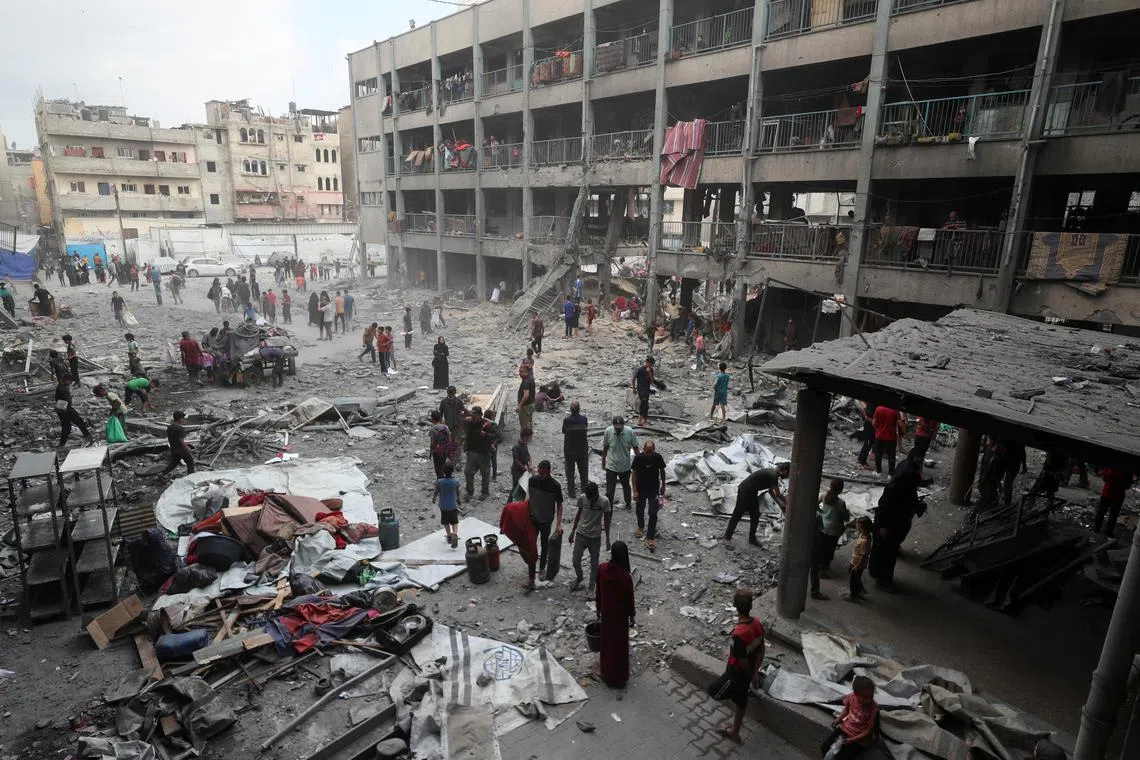Israel steps up Gaza bombardment ahead of White House talks on ceasefire
Sign up now: Get ST's newsletters delivered to your inbox

Palestinians inspecting damage from an Israeli air strike at a school sheltering people in Gaza City, on June 30.
PHOTO: REUTERS
Follow topic:
CAIRO/JERUSALEM – Palestinians in northern Gaza reported one of the worst nights of Israeli bombardment in weeks after the military issued mass evacuation orders on June 30, while Israeli officials were due in Washington for a new ceasefire push by the Trump administration.
A day after US President Donald Trump urged an end to the 20-month-old war
But on the ground in the Palestinian enclave, there was no sign of fighting letting up.
“Explosions never stopped; they bombed schools and homes. It felt like earthquakes,” said Mr Salah, 60, a father of five, from Gaza City. “In the news we hear a ceasefire is near, on the ground we see death and we hear explosions.”
Israeli tanks pushed into the eastern areas of Zeitoun suburb in Gaza City and shelled several areas in the north, while aircraft bombed at least four schools after ordering hundreds of families sheltering inside to leave, residents said.
At least 58 people were killed in Israeli strikes on June 30, the health authorities said, including 10 people in Zeitoun and at least 13 killed south-west of Gaza City. Medics said most of the 13 were hit by gunfire, but residents also reported an air strike.
The Israeli military said it struck militant targets in northern Gaza, including command and control centres, after taking steps to mitigate the risk of harming civilians.
There was no immediate word from Israel on the reported casualties south-west of Gaza City.
The heavy bombardment followed new evacuation orders to vast areas in the north, where Israeli forces had operated before and left behind wide-scale destruction. The military ordered people there to head south, saying that it planned to fight Hamas militants operating in northern Gaza, including in the heart of Gaza City.
Next steps
A day after Mr Trump called to “make the deal in Gaza, get the hostages back”, Israel’s Strategic Affairs Minister Ron Dermer, a confidant of Mr Netanyahu, was expected on June 30 at the White House for talks on Iran and Gaza, an Israeli official said.
In Israel, Mr Netanyahu’s security Cabinet was expected to convene to discuss the next steps in Gaza.
On June 27, Israel’s military chief said the present ground operation was close to having achieved its goals, and on June 29, Mr Netanyahu said new opportunities had opened up for recovering the hostages, 20 of whom are believed to still be alive.
Palestinian and Egyptian sources with knowledge of the latest ceasefire efforts said mediators Qatar and Egypt have stepped up their contacts with the two warring sides, but that no date has been set yet for a new round of truce talks.
A Hamas official said progress depends on Israel changing its position and agreeing to end the war and withdraw from Gaza. Israel says it can end the war only when Hamas is disarmed and dismantled. Hamas refuses to lay down its arms.
Israeli Foreign Minister Gideon Saar said Israel has agreed to a US-proposed 60-day ceasefire and hostage deal, and put the onus on Hamas.
“Israel is serious in its will to reach a hostage deal and ceasefire in Gaza,” Mr Saar told reporters in Jerusalem.
Austrian Foreign Minister Beate Meinl-Reisinger, speaking in Jerusalem on June 30 alongside her Israeli counterpart, told reporters that Vienna was very concerned about the humanitarian situation in Gaza, which she described as “unbearable”.
“Let me be frank, the suffering of civilians is increasingly burdening Israel’s relations with Europe. A ceasefire must be agreed upon,” she said, calling for the unconditional release of hostages by Hamas and for Israel to allow the uninterrupted flow of humanitarian aid into Gaza.
Israel says it continues to allow aid into Gaza and accuses Hamas of stealing it. The group denies that accusation, and says Israel uses hunger as a weapon against the Gaza population.
The war began when Hamas fighters stormed into Israel on Oct 7, 2023,
Israel’s subsequent military assault has killed more than 56,000 Palestinians, most of them civilians, according to the Gaza Health Ministry, displaced almost the entire 2.3 million population, and plunged the enclave into a humanitarian crisis.
More than 80 per cent of the territory is now an Israeli-militarised zone or under displacement orders, according to the United Nations. REUTERS

